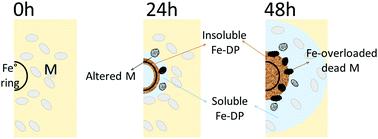当前位置:
X-MOL 学术
›
Metallomics
›
论文详情
Our official English website, www.x-mol.net, welcomes your
feedback! (Note: you will need to create a separate account there.)
Effect of degradation products of iron-bioresorbable implants on the physiological behavior of macrophages in vitro
Metallomics ( IF 2.9 ) Pub Date : 2020-10-29 , DOI: 10.1039/d0mt00151a Natalia S Fagali 1 , Marcos A Madrid , Blanca T Pérez Maceda , María E López Fernández , Rosa M Lozano Puerto , Mónica Fernández Lorenzo de Mele
Metallomics ( IF 2.9 ) Pub Date : 2020-10-29 , DOI: 10.1039/d0mt00151a Natalia S Fagali 1 , Marcos A Madrid , Blanca T Pérez Maceda , María E López Fernández , Rosa M Lozano Puerto , Mónica Fernández Lorenzo de Mele
Affiliation

|
The degradation of bioresorbable metals in vivo changes the physicochemical properties in the environment of an implant, such as a stent in the artery wall, and may induce the alteration of the functions of the surrounding cells. The Fe-degradation, from bioresorbable stents, is a particularly intricate process because it leads to the release of soluble (SDP) and insoluble degradation products (IDP) of varied composition. Macrophages are involved in the resorption of the exogenous agents coming from degradation of these materials. In the present work an Fe0 ring, made with a pure Fe wire, in contact with macrophage cell cultures was used to simulate the behaviour of a biodegradable Fe-based implant in a biological environment. Non-invasive time-lapse optical microscopy was applied to obtain images of macrophages exposed to Fe-degradation products, without using staining to avoid distortions and artefacts. It was noticed that as metal degraded, the IDP formed in situ accumulated close to the Fe0 ring. In this zone, the macrophages showed a dynamic process of uptake of dark Fe-containing products, confirmed by SEM-EDX. These macrophages showed alterations in the morphology and decrease in the motility and viability. The inability of the macrophages to move and to degrade the engulfed products caused a long persistence of IDP in the zone closest to the metal. The deleterious effects of IDP accumulated close to the ring, were significantly worse than those observed in the experiments made with (1) concentrated salt solutions (Fe3+ salt 3 mM), with the same amount of precipitates but uniformly distributed in the well, and (2) diluted salt solutions (Fe3+ salt 1 mM) with mainly soluble species. The results were confirmed by standard staining protocols that revealed dead cells close to the Fe0 ring and oxidative stress in cells exposed to both soluble and insoluble species.
中文翻译:

铁生物可吸收植入物降解产物对体外巨噬细胞生理行为的影响
生物可吸收金属在体内的降解改变了植入物环境中的物理化学性质,例如动脉壁中的支架,并可能引起周围细胞功能的改变。来自生物可吸收支架的铁降解是一个特别复杂的过程,因为它会导致不同成分的可溶性 (SDP) 和不溶性降解产物 (IDP) 的释放。巨噬细胞参与来自这些材料降解的外源性物质的再吸收。在目前的工作中,Fe 0用纯铁线制成的环与巨噬细胞培养物接触,用于模拟可生物降解的铁基植入物在生物环境中的行为。应用非侵入性延时光学显微镜来获得暴露于铁降解产物的巨噬细胞的图像,而不使用染色以避免变形和伪影。注意到随着金属降解,原位形成的 IDP在接近 Fe 0戒指。在该区域中,巨噬细胞显示出吸收深色含铁产物的动态过程,SEM-EDX 证实了这一点。这些巨噬细胞表现出形态的改变以及运动性和活力的降低。巨噬细胞无法移动和降解被吞没的产物,导致 IDP 在最接近金属的区域长期持续存在。IDP 在环附近积累的有害影响明显比在使用 (1) 浓盐溶液 (Fe 3+盐 3 mM)进行的实验中观察到的更严重,具有相同数量的沉淀物但均匀分布在孔中, (2) 稀盐溶液(Fe 3+盐 1 mM),主要是可溶性物质。结果由标准染色方案证实,该方案揭示了接近 Fe 0环的死细胞和暴露于可溶性和不溶性物质的细胞中的氧化应激。
更新日期:2020-11-06
中文翻译:

铁生物可吸收植入物降解产物对体外巨噬细胞生理行为的影响
生物可吸收金属在体内的降解改变了植入物环境中的物理化学性质,例如动脉壁中的支架,并可能引起周围细胞功能的改变。来自生物可吸收支架的铁降解是一个特别复杂的过程,因为它会导致不同成分的可溶性 (SDP) 和不溶性降解产物 (IDP) 的释放。巨噬细胞参与来自这些材料降解的外源性物质的再吸收。在目前的工作中,Fe 0用纯铁线制成的环与巨噬细胞培养物接触,用于模拟可生物降解的铁基植入物在生物环境中的行为。应用非侵入性延时光学显微镜来获得暴露于铁降解产物的巨噬细胞的图像,而不使用染色以避免变形和伪影。注意到随着金属降解,原位形成的 IDP在接近 Fe 0戒指。在该区域中,巨噬细胞显示出吸收深色含铁产物的动态过程,SEM-EDX 证实了这一点。这些巨噬细胞表现出形态的改变以及运动性和活力的降低。巨噬细胞无法移动和降解被吞没的产物,导致 IDP 在最接近金属的区域长期持续存在。IDP 在环附近积累的有害影响明显比在使用 (1) 浓盐溶液 (Fe 3+盐 3 mM)进行的实验中观察到的更严重,具有相同数量的沉淀物但均匀分布在孔中, (2) 稀盐溶液(Fe 3+盐 1 mM),主要是可溶性物质。结果由标准染色方案证实,该方案揭示了接近 Fe 0环的死细胞和暴露于可溶性和不溶性物质的细胞中的氧化应激。











































 京公网安备 11010802027423号
京公网安备 11010802027423号